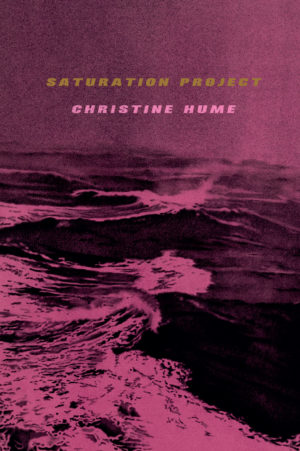Saturation Project
by Christine Hume
reviewed by Constance Hansen
Saturation Project is a lyric memoir by Christine Hume, the author of three books of poetry and six prose chapbooks. The book consists of three interlocking essays: “Atalanta: An Anatomy,” “Hum,” and “Ventifacts.” While they call back and forth to each other, the essays are complete in themselves.
“Atalanta” explores girlhood through the eponymous heroine, a Greek huntress allied with Artemis. Myth is braided with historical accounts of bear-fostered girls ancient and modern, who constellate around the speaker’s recounting of her own girlhood. The essay defies narrative, yet its innuendos haunt the speaker as well as the listener; we struggle in and out of memory as if through an overgrown wood. The speaker scatters breadcrumbs that suggest childhood sexual abuse and incest. Disturbing images blend with innocence, carrying plausible deniability: “A girl puts on claws and plays bear with her father until her mother finds them in bed together.” An aura of danger prevails in these woods. Girls here are prey: “When I say hunters, I mean fathers.” The speaker leans into paradox: “She did not question the facts of the forest; she was the shared understanding between hunted and hunters.” There are also attestations of the freedom and animism present in the wilderness of girlhood. Feral girls share a forest consciousness until they are captured; the bears that nursed them are killed. The wild feminine and feminine wild are exploited, even extinguished, by men.
In “Hum,” the speaker identifies with sound as much as self. She asks, “How to tell the singer from the song?” and notes that in order to spell the surname “Hume,” one must first write “hum.” Following on the previous essay’s gestures toward trauma, humming here reads as a coping mechanism. The hummer sets about “echolocating herself” and avoiding the “perverse advances” of family. The speaker deals again and again in doubleness: “Tuning in and tuning out are two sides of the same face,” or “With equal anguish, I called to and called off a female body.” The essay presents etymology as genesis; “hum” comes from the Old English “hommen,” “to make murmuring sound to cover embarrassment,” recalling a survivor’s sense of shame. The hum insists on taking up space: each page contains a line of “h,” “u,” “m” from edge to edge. As if reading sheet music, one hears “om,” the primordial sound of the universe. The speaker’s hum is generative as well as suppressive. Poets write prose with music in it, and Hume writes with music about music: “Even now, I swallow humming into my sentences, and it defies your desire to know what it’s about, denying your lust for narrative.”
The third essay, “Ventifacts,” explores the power of the wind. The speaker’s daughter is terrorized by its elemental eeriness, and the speaker asks, “Is it sadistic not to shelter my daughter?” We are told that a ventifact is quite literally a “wind artifact,” the sculpted rock that wind shapes over time. Wind may well be code for time. The return to girlhood, through the vehicle of the daughter, makes this memoir matrilineal. From the first entry, we are situated in the overlap between myth and menstruation: “Curses of the furies, songs of the sirens, the babblings of Cassandra … all those horrifying sounds burbling up from a female body.” While “Hum” concerns itself with the expression of sound, “Ventifacts” explores aural knowledge: “Instead of watching wind through a window, we try putting our ears to the glass.” In this way, the third essay listens to the second.
As a synoptic triptych of essays whose components flirt with memoir and prose poetry, Saturation Project is formally inventive, like Citizen by Claudia Rankine or Bluets by Maggie Nelson. Each employs collage and nonlinear storytelling to create a prismatic experience full of surprising juxtapositions. Like Rankine and Nelson, Hume is in total control of tone as she weaves the visceral with the cerebral. The effect is a contrast between a leaping, luscious intellect and the heaviness on which it focuses.
Published on January 13, 2022

